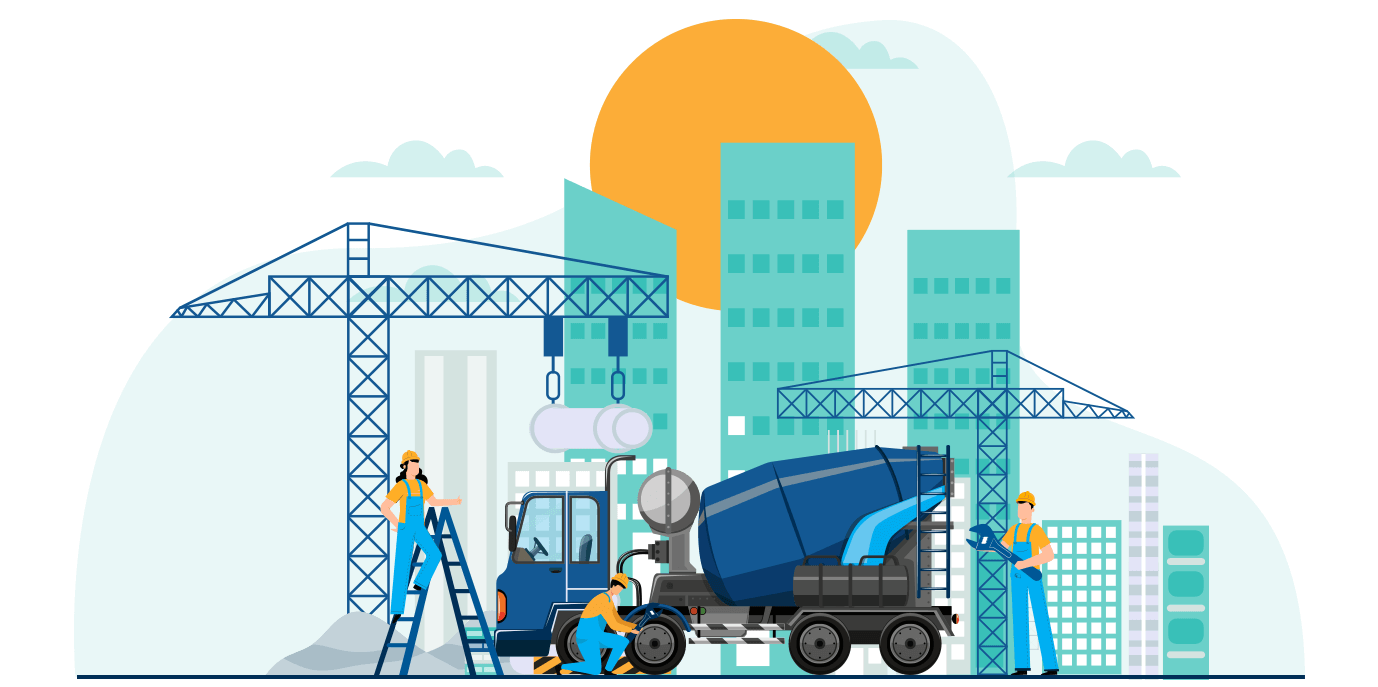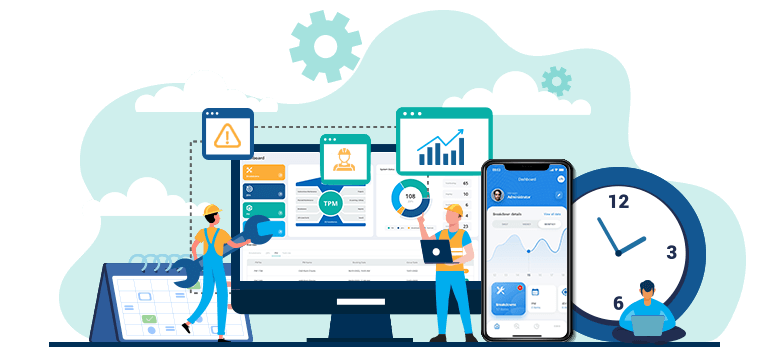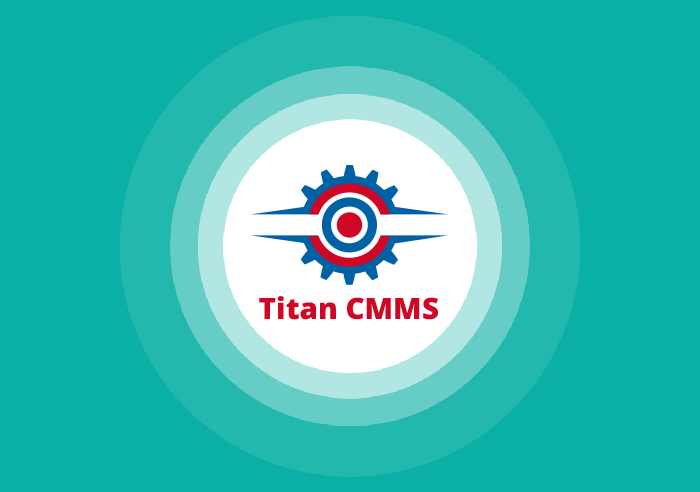
CMMS for Construction Industry
TITAN CMMS software is an excellent tool to help you stay on track regarding all maintenance work and maintenance requests from the construction site. Construction projects mainly depend a lot on construction assets and their availability; therefore, it is important to keep the assets readily available. Knowing the importance of a CMMS, construction companies have started incorporating it into their operations. Organisations can easily plan and manage all maintenance-related activities using the TITAN CMMS software.CMMS offers comprehensive visibility across all operations, making it easy to control the project from anywhere.
All-in-One Solution for Maintenance Management
With TITAN CMMS in place, unplanned breakdowns will be a thing of the past. Regular maintenance and service ensure that the equipment functions effectively throughout its lifecycle. TITAN CMMS tracks all information related to each asset, and maintenance history helps the team schedule recurring maintenance checks to avoid downtime.
- Ensure the availability of assets/equipment
- Real-time notifications when maintenance work is needed
- Schedule maintenance activities to avoid downtime
- Inventory management
- Monitor and track assets

TITAN CMMS - The Key to Optimise Maintenance Operations
Smart Solution
Worried about managing maintenance operations? TITAN CMMS is here to help! TITAN help organisations track and manage all maintenance-related tasks, boosts asset efficiency and performance, by creating a maintenance request, breakdown request, just do it (JDI), and tasks, at any time from anywhere.
Start Free Trial Watch Video Tell a FriendWhat is CMMS?
Have you been struggling with centralising and managing maintenance-related information? The solution is right here, CMMS software eases the process of maintenance operations by streamlining maintenance information. Computerised Maintenance Management System (CMMS) software, also known as Computerised Maintenance Management Information System (CMMIS), help organisations plan, schedule, and track all maintenance activities by effectively managing work orders, assets and inventory. The maintenance management system collects information from relevant KPIs and evaluates maintenance tasks’ performance and effectiveness.

Contents
- What is CMMS in Construction?
- Why is CMMS important for Construction Businesses?
- Who can benefit from using CMMS in Construction Projects?
- How can Construction Companies implement the CMMS System?
- How can you handle the complex Construction Maintenance tasks with a CMMS software?
- Key benefits of using CMMS for Construction Maintenance
- What types of Construction equipment can be managed with CMMS?
- How does CMMS facilitate report generation for Construction Maintenance activities?
- Can CMMS be integrated with existing Construction Management Systems?
- How user-friendly is CMMS Software for Construction Maintenance teams?
- How scalable is CMMS for the growing Construction Sector?
- Example of CMMS implementation in Construction Industry
- How can CMMS help address challenges in Construction and Building Management?
- How does CMMS help construction enterprises increase their ROI?
What is CMMS in Construction?
In the construction sector, CMMS, or Computerised Maintenance Management System, is a comprehensive software solution which can streamline and optimise maintenance operations for construction equipment and facilities. By utilising CMMS for construction and building management, operators can effectively enhance equipment uptime, reduce downtime, and manage maintenance costs. The CMMS system ensures efficient work order generation, facilitates report generation for maintenance activities, and integrates seamlessly with existing Construction Management Systems (CMS), providing a centralised platform for overseeing all aspects of construction equipment maintenance.
Why is CMMS important for Construction Businesses?
CMMS software is important for construction businesses because it can simplify maintenance operations. CMMS software plays a crucial role in managing work orders, scheduling preventative maintenance programs, and tracking the maintenance history of construction assets. CMMS software helps minimise equipment downtime, optimise resource utilisation, and reduce overall maintenance costs. With CMMS, construction businesses gain real-time insights into equipment performance and maintenance needs, enabling them to make data-driven decisions and ensure the smooth operation of their projects. Ultimately, CMMS software empowers construction sectors to enhance productivity, prolong equipment lifespan, and maintain a competitive edge in the industry.
Who can benefit from using CMMS in Construction Projects?
Various stakeholders involved in different phases of construction project management can benefit from using CMMS. Construction project managers can utilise CMMS to track equipment performance and ensure the timely completion of maintenance tasks within budget constraints. Maintenance technicians benefit from CMMS by having access to detailed work orders, maintenance schedules, and equipment maintenance reports, enabling them to perform their duties more efficiently. Facility managers can leverage CMMS to oversee maintenance activities across multiple construction sites, prioritise tasks, and allocate resources effectively. Additionally, subcontractors and vendors involved in construction projects can use CMMS to coordinate maintenance activities, schedule inspections, and communicate seamlessly with other stakeholders about ongoing maintenance tasks. By integrating CMMS into various phases of construction project management, all parties involved can enhance productivity, minimise downtime, and deliver successful outcomes.
How can Construction Companies implement the CMMS System?
Implementing a CMMS for the construction sector involves several steps that could optimise maintenance activities. Here are the simple steps you could follow to implement CMMS for your construction industry:
- Make an Assessment and Plan for Maintenance activities:
- Evaluate current maintenance processes and identify areas for improvement.
- Define maintenance goals and objectives for implementing the CMMS.
- Establish a project team and designate roles and responsibilities.
- Research and Select the best CMMS software:
- Research CMMS software options tailored specifically for construction equipment maintenance.
- Consider factors such as scalability, integration capabilities, and user-friendliness.
- Request demos and trials to assess the suitability of the software for your organisation's maintenance needs.
- Transfer necessary data and setup processes:
- Identify data sources and gather relevant maintenance records, equipment lists, and inventory data.
- Cleanse and standardise data to ensure accuracy and consistency.
- Work with the CMMS provider to import data into the system and configure settings based on organisational requirements.
- Skill up your team with Training Sections:
- Provide adequate training sessions for employees at all levels involved in maintenance operations.
- Offer hands-on workshops and tutorials to familiarise users with CMMS functionalities.
- Develop training materials and resources for ongoing support and reference.
- Run a Pilot Testing:
- Select a pilot group or department to test the CMMS in a real-world environment.
- Monitor system performance, user feedback, and adherence to established workflows.
- Identify issues or challenges encountered during the testing phase and address them promptly.
- Ensure Full-Scale Deployment:
- Roll out the CMMS across all departments and construction sites.
- Communicate implementation timelines, expectations, and benefits to stakeholders.
- Provide ongoing support and assistance to users as they transition to the new CMMS system.
- Monitor the process frequently:
- Review maintenance KPIs (Key Performance Indicators) and user feedback regularly.
- Identify improvement areas and optimisation within the CMMS workflows.
- Adjust configurations, processes, and training programs to maximise the software's effectiveness.
How can you handle the complex Construction Maintenance tasks with a CMMS software?
CMMS software is well-equipped to handle complex construction maintenance tasks efficiently. With advanced features tailored for the construction industry, CMMS ensures seamless work order generation, allowing for the systematic scheduling and tracking of maintenance activities. CMMS software facilitates the management of complex maintenance tasks by providing comprehensive tools for overseeing maintenance programs, tracking equipment maintenance logs and managing resources effectively. CMMS ensures that maintenance tasks are completed promptly through automated notifications, prioritisation features, and real-time monitoring of maintenance tasks. Its ability to handle complex maintenance scenarios makes CMMS an essential tool for construction companies seeking to optimise their maintenance processes and enhance equipment reliability.
Key benefits of using CMMS for Construction Maintenance
- Improved Asset Management: Construction CMMS allows for centralised equipment tracking, including maintenance logs, repair costs, and warranty information, optimising asset utilisation and lifespan. Many CMMS platforms offer mobile applications, allowing maintenance technicians to access work orders and update asset information on the go.
- Streamlined Work Order Generation: CMMS enables quick and efficient generation of work orders, ensuring maintenance tasks are assigned, prioritised, and completed promptly.
- Cost Savings: By implementing preventive maintenance programs and effectively managing maintenance schedules, CMMS helps reduce unexpected repair costs and extends the life of construction equipment.
- Compliance and Documentation: CMMS software maintains comprehensive records of maintenance activities, facilitating regulatory compliance and providing documentation for audits and inspections.
- Increased Productivity: With streamlined maintenance processes and improved resource allocation, CMMS enhances overall productivity by minimising downtime and maximising equipment availability.
- Real-Time Reporting and Analysis: Construction CMMS offers real-time maintenance reporting and analytics capabilities, allowing stakeholders to monitor maintenance performance, identify trends, and make data-driven decisions for process improvement.
- Enhanced Communication and Collaboration: CMMS fosters better communication and collaboration among maintenance teams, subcontractors, and other stakeholders by providing a centralised platform for sharing information and tracking progress.
What types of Construction equipment can be managed with CMMS?
CMMS can manage a wide range of construction equipment, including but not limited to heavy machinery such as excavators, cranes, and loaders. It also extends its functionality to smaller tools and vehicles commonly used on construction sites, such as generators, compressors, and drills. Additionally, CMMS can effectively manage specialised equipment like concrete mixers and welding machines. The versatility of CMMS allows construction companies to maintain comprehensive maintenance records, schedule preventive maintenance, and track the performance of all equipment types across various projects, ensuring optimal functionality and longevity throughout their asset lifecycle.
How does CMMS facilitate report generation for Construction Maintenance activities?
CMMS simplifies report generation for construction maintenance activities by providing comprehensive data aggregation and analysis tools. Users can access detailed insights into maintenance tasks and equipment performance. CMMS automatically captures maintenance records through the CMMS system, including work orders, downtime incidents, and repair histories, streamlining the maintenance reporting process. It offers customisable maintenance reporting templates and dashboards, allowing users to generate tailored reports based on specific criteria such as equipment status, maintenance costs, and compliance metrics. With real-time visibility into maintenance activities, construction stakeholders can make informed decisions, identify trends, and implement proactive strategies to optimise maintenance operations effectively.
Can CMMS be integrated with existing Construction Management Systems?
Integrating CMMS with existing Construction Management Systems (CMS) makes it possible to create a seamless workflow and enhance overall project efficiency. The integration between CMMS and CMS allows for exchanging crucial data and information related to construction maintenance and project management. By integrating both these systems, construction companies can synchronise maintenance schedules, share equipment and asset data, and streamline communication between maintenance teams and project managers. This integration ensures that maintenance activities are aligned with project timelines and objectives, leading to better resource allocation, improved decision-making, and enhanced productivity across construction projects.
How user-friendly is CMMS Software for Construction Maintenance teams?
CMMS systems for construction typically feature user-friendly dashboards, customisable layouts, and simple navigation menus, allowing maintenance technicians to access the critical information and perform tasks efficiently. Additionally, the best CMMS for construction often comes with training resources, tutorials, and customer support to assist users in mastering the software and maximising its capabilities. With user-friendly interfaces and robust support mechanisms, CMMS software empowers construction maintenance teams to effectively manage equipment, streamline workflows, and optimise maintenance operations with minimal training or technical expertise required.
How scalable is CMMS for the growing Construction Sector?
CMMS is highly scalable for growing construction sectors, offering flexibility and adaptability to accommodate expanding operations and increasing maintenance needs. CMMS systems can easily scale up to manage many assets, projects, and users without sacrificing performance or functionality. CMMS platforms often feature modular designs and customisable configurations, allowing construction companies to tailor the software to their evolving requirements and workflows. Additionally, cloud-based CMMS solutions offer virtually limitless scalability, enabling construction companies to add new users, locations, and features as their business expands. With its scalable architecture and customisable capabilities, CMMS empowers growing construction companies to manage maintenance operations effectively and confidently drive business growth.
Example of CMMS implementation in Construction Industry
Consider a scenario where a construction company decides to implement CMMS to manage the maintenance of cranes. The construction company benefits from CMMS implementation by effectively managing crane maintenance and ensuring safety, compliance, and operational efficiency.
- Identifying Maintenance Needs: Recognising the significance of crane maintenance due to safety and performance concerns.
- Utilising CMMS for Maintenance Scheduling: Implementing CMMS to schedule preventive maintenance tasks for cranes.
- Customising Maintenance Plans: Tailoring maintenance schedules based on usage hours, manufacturer recommendations, and regulatory standards.
- Automating Work Order Generation: Using CMMS to generate work orders automatically for crane inspections, lubrication, and component replacements.
- Proactive Maintenance Management: Proactively managing crane maintenance to minimise the risk of unexpected breakdowns.
- Enhancing Worker Safety: Ensuring regular maintenance improves safety for workers operating around cranes.
- Prolonging Equipment Lifespan: Extending the lifespan of critical equipment by implementing effective maintenance strategies.
- Report generation and ensuring compliance: Leveraging CMMS to document maintenance activities to ensure regulatory compliance.
- Cost Analysis and Efficiency: Utilising CMMS data for cost analysis and operational efficiency improvements.
How can CMMS help address challenges in Construction and Building Management?
- Downtime Due to Equipment Failures: CMMS reduces the likelihood of unexpected breakdowns and minimises equipment downtime to ensure quality production.
- Inefficient Work Order Management: CMMS streamlines work order generation, prioritisation, and assignment, ensuring tasks are completed promptly and efficiently.
- Lack of Asset Visibility and Tracking: CMMS provides centralised tracking of assets, including maintenance history and location, facilitating better asset management and utilisation.
- Compliance and Regulatory Issues: CMMS can maintain maintenance records, ensure compliance with regulatory standards and simplify audit processes.
- High Maintenance Costs: CMMS helps optimise maintenance schedules, track costs, and identify areas for cost reduction, ultimately lowering overall maintenance expenses for construction and building management.
How does CMMS help construction enterprises increase their ROI?
CMMS significantly contributes to increasing ROI (Return on Investment) for construction enterprises by optimising maintenance operations and enhancing asset management practices. Through features such as preventive maintenance scheduling, work order automation, and real-time asset tracking, CMMS helps minimise equipment downtime, reduce repair costs, and extend asset lifespan. By tracking maintenance costs for construction projects, CMMS enables accurate budgeting and cost forecasting, preventing unexpected expenses and maximising financial resources. Additionally, by streamlining workflows and improving operational efficiency, CMMS enhances productivity, enabling construction enterprises to complete projects faster and capitalise on new opportunities, ultimately leading to higher Return on Investment.















